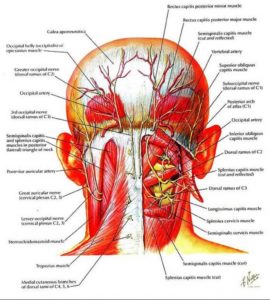Zeljko Kojadinovic, MD- Neurosurgeon and Pain Specialist
The spinal column allows a person to walk upright. It consists of 33-35 vertebrae (bone elements) between which are discs that function as shock absorbers. There are 3 parts of the spine: cervical, thoracic and lumbosacral. Muscles are attached to the spinal column that enables various movements. Inside the spinal column, there is a canal in which the spinal cord and the beginnings (roots) of the spinal nerves are located. These nerves innervate the body.
Figure: Anatomy of the spine – upper-neck segment, middle-thoracic segment, lower- lumbosacral segment
MOST SYMPTOMS RELATED TO THE CERVICAL SPINE CAN BE TREATED BY NON-SURGICAL (CONSERVATIVE) METHODS. WE THINK EVERY NEUROSURGEON SHOULD THINK VERY CRITICALLY IN DECIDING WHETHER OR NOT TO OPERATE ON THE SPINE. EVERY POSITIVE MAGNETIC RESONANCE IMAGING (e.g., DISC PROTRUSION OR HERNIATION, SPONDYLOSIS, INSTABILITY) REQUIRES AN EXAMINATION BY A NEUROSURGEON. IN MOST OF THESE CASES, SURGERY IS NOT INDICATED. GREAT THEORETICAL KNOWLEDGE AND PROFESSIONAL EXPERIENCE IN THIS FIELD IS REQUIRED IN ORDER TO MAKE THE CORRECT DECISION REGARDING WHEN SPINE SURGERY IS INDICATED, AND WHEN IT IS NOT. MOST SYMPTOMS AND DISEASES OF THE CERVICAL SPINE CAN BE TREATED WITH MEDICATION. THE COMBINATION AND DOSAGE OF MEDICATION MUST BE INDIVIDUALLY PRESCRIBED AND ARE NOT THE SAME FOR EVERY PATIENT. TO ACHIEVE THIS, BESIDE SPINAL IMAGES, DETAILED COMMUNICATION WITH THE PATIENT IS REQUIRED.
Painful syndromes in the cervical spine
Neck pain is very common in every population. Almost everyone has experienced at least occasional neck pain. Unfortunately, there are many patients who have frequent painful phases in the neck, or the pain is constant. Initial diagnosis can be chronic neck pain, brachialgia, spondylosis or something similar. In fact, these diagnoses are not precise at all, but in milder cases they are sufficient to begin treatment (use of analgesics with or without physical treatment). If the pain persists despite this therapy, or recurs frequently, it is necessary to determine the exact cause of the pain. These diseases are very frequent around the world in different countries (USA, Nigeria, Kenya, Tanzania, Germany, Japan, etc.).
Diseases of the spine that look like a cervical disc herniation
There are a number of diseases that cause the same pain in the neck, which can spread to the occipital region of the head, shoulder or arm. Examples of such diseases are: occipital neuralgia, facet syndrome, myofascial pain of certain numerous muscles, entrapment syndromes of certain nerves, (e.g., Suprascapular nerve, nerve root-radiculopathy), inflammation of ligament attachment, tightening of various ligaments, etc.
Neck pain- Causes
The cause of the pain can be one or more structures in the form of pain points (often about 1 cm in diameter). Every region of the body has a large number of possible sources of pain (10-20 per region). For example, the same neck pain in different patients can originate from about 20 different structures that usually each require specific treatment. Good knowledge of the pain anatomy makes it possible to determine exactly which structure hurts.
Neck pain can occur due to inflammation, spasm or pressure in many tissues (e.g., muscles, ligaments, joints, capsules and attachments of these structures, nerves, etc.).
The occurrence of these diseases is associated with improper posture, obesity, trauma, weakness of the muscles that support the spine (deep muscles around the spine). Constant pressure on the spine also contributes to their appearance (overweight, heavy workloads, irregular bending and lifting movements, excessive sports activities, etc.).
The disease can also begin in the context of various rheumatic diseases or as a result of injuries.
Spine problems are also common in diseases that attack a large number of organs, e.g., systemic autoimmune diseases, osteoporosis, some blood diseases, malignant diseases, diseases that lead to the reduced movement for a long time, etc.
Many diseases of the surrounding organs can cause pain that mimics diseases of the spine (thyroid, some neck muscles, laryngeal pain, etc.)
Neck pain- Symptoms
Neck pain, shoulder and arm pain (brachialgia) are the most common types of pain. They can be like typical pain, but sometimes they can also be like a burning pain. Another symptom is low mobility of the spine. There can also be sensitivity symptoms (most often numbness or tingling in the fingers). Muscle weakness of the arm may also occur.
Neck pain-Diagnosis
The task of diagnostics is to discover the real cause of neck pain, especially when it is resistant to treatment. The most important thing during the examination is to talk in detail with the patient about all of his or her symptoms, to consider all possible causes of pain and then to confirm or exclude them through additional examinations.
Here is an illustration of the wrong approach: You come to the doctor because of long-term neck pain. He immediately orders a cervical spine MRI and on the MRI images tries to see the cause of your pain and determine the best course of treatment.
After examination, images may be indicated: X-ray, CT and MRI of the spine, EMG, blood lab, etc. All of these images should be analyzed according to all of the symptoms the patient has. In about 50% of cases the cause of the pain is not visible on these images. There is a possibility that one of these causes of pain could be masked by a disc herniation that can be seen on the MRI, and whose surgical removal would not lead to a reduction in pain.
Sometime there is an indication for a diagnostic-therapeutic interventional pain procedures to find a source of the pain. One ml of local anesthetic is injected under navigation (by ultrasound, X-ray or CT) into a suspected cause of the pain. If the pain stops, it can be the cause of the pain.
If you suffer from persistent pain, we offer you a video consultation with our pain management expert, who will aim to precisely determine the exact cause of your pain and then prescribe the appropriate treatment. If you suffer from persistent pain, it obviously means that your doctors have not yet achieved this for you.
Neck pain-Treatment
If the source of pain and pathological process that irritates are not discovered, treatment is usually not successful or the results are not long-lasting. If the exact origin of the pain is discovered, even after a long period of pain, success is achieved in over 80% of cases.
The above-mentioned diseases are usually not treated surgically.
Treatment can include:
• medications (different combinations and dosages should always be prescribed individually)
• special means of relieving the source of pain from mechanical irritations – special collars, losing weight, changing habits, reducing workloads, etc.
• physical therapy – traction, exercise, education, relaxation, heat, magnet, therapeutic ultrasound
• invasive treatment procedures- application of medications by injection in the sources of the pain, heat denervation.
• acupuncture
• chiropraxis
• alternative methods
• surgical methods – usually spine surgery,
• implanting spinal and nerve stimulators
The first step in the treatment is the most important. After determining the real cause of the neck pain, an individual combination and dosages of medication can be prescribed. This combination of medication is always individual and should be adjusted in regular contact with the patient over the first 6 weeks. At the beginning of this period the pain should be significantly reduced or completely solved. It should remain so to the end of the 6 weeks in order to achieve long-lasting results. To provide this during this period, the doctor must be available to the patient at any time so that he can easily contact him if the pain increases.
Image: only partially shows various structures that can be a source of neck pain. And all of them can manifest the same neck pain that can spread to the shoulder or occipital headache. However, they must be accurately diagnosed because their treatment is different
Cervical disc herniation
Diseases of the cervical spine are numerous and mostly begin with various pain syndromes. The most common pain is in the neck with or without spreading to the head, shoulder and arms. In advanced disease, and sometimes from the very beginning, there may be signs of damage to the spinal cord and/or the beginnings (roots) of the nerves (myelopathy and radiculopathy). They are manifested by weakness, numbness, tingling or clumsiness in the arms and/or legs. There is often a feeling of dizziness and instability, especially with some movements in the neck….
Cervical spine injuries
The most usual is the cervical distortion. The English nomenclature uses an even larger number of terms to describe this injury: Neck Strain, Neck Sprain, Cervical Strain, Cervical Sprain, Flexion-Extension Injury, Cervical Hyperextension Injury, Acceleration-Deceleration Injury, Soft-Tissue Neck Injury, etc
Frequently Asked Questions
1. Please give me some advice: I underwent two operations on the cervical spine. I still experience constant pain in my neck and the top of my head. I don’t know where to go for help!
Answer:
Disc surgery on the cervical spine does not solve all the pain in the neck and head. Furthermore, it is important to seek the help of a specialist who deals with the treatment of pain and who will determine which structures are attacked by which diseases and what it is that is really causing this pain. Then adequate treatment can be prescribed.




